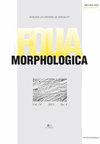The morphological variability of the piriformis muscle.
IF 1.2
4区 医学
Q3 ANATOMY & MORPHOLOGY
引用次数: 0
Abstract
BACKGROUND The aim of the study is to create several classifications of the piriformis muscle (PM): proximal and distal attachments, potential fusions, and the relationship with the sciatic nerve. It is the first comprehensive anatomical examination of this subject. MATERIALS AND METHODS One hundred and twenty-four lower limbs from 62 cadavers, fixed in 10% formalin, were examined. RESULTS The piriformis muscle was present in 120 limbs (96.8% of cases). Four types of proximal attachment were described (I-IV). The most common type was Type I, in which the proximal attachment was at the anterior surface of the sacrum, between S2 and S4 (52 lower limbs; 43.3%). The rarest type was Type IV, in which the proximal attachment was at the gluteal surface of the ilium near the margin of the greater sciatic notch and from the gluteus medius (12 cases; 10%). Three types of distal attachment were distinguished. The most common was Type 1, a single tendon. This type comprised two subtypes: A and B (105 lower limbs; 87.5%). The other two types accounted for 12.5% of the total. Fusions were noted between the piriformis muscle and adjacent muscles in 31.7%. Four patterns were observed in which the sciatic nerve ran against the piriformis muscle. The most common variation in the relationship was the common fibular nerve exiting superior to the piriformis muscle and the tibial nerve passing inferior to it (10 cases; 8.3%). CONCLUSIONS The piriformis muscle is highly morphologically variable in both its proximal and distal attachments and its relationship with the sciatic nerve. There are four types of proximal attachment and three types of distal attachment. The piriformis muscle shows numerous fusions with its adjacent muscles: gluteus medius or minimus or superior gemellus. A new (fourth) type of relationship was demonstrated between the piriformis muscle and sciatic nerve. The piriformis muscle was absent in four cases.梨状肌的形态变化。
背景该研究旨在对梨状肌(PM)进行几种分类:近端和远端附着、潜在的融合以及与坐骨神经的关系。这是首次对这一主题进行全面的解剖学研究。材料和方法研究人员对来自 62 具尸体的 224 个下肢进行了检查,这些尸体均固定在 10% 福尔马林中。描述了四种近端附着类型(I-IV)。最常见的类型是 I 型,即近端附着在骶骨前表面,位于 S2 和 S4 之间(52 例下肢;43.3%)。最罕见的类型是 IV 型,即近端附着在髂骨的臀部表面,靠近坐骨大切迹边缘和臀中肌(12 例;10%)。远端附着分为三种类型。最常见的是类型 1,即单一肌腱。这种类型包括两个亚型:A型和B型(105例下肢;87.5%)。其他两种类型占总数的 12.5%。有 31.7% 的人发现梨状肌与邻近肌肉融合。坐骨神经与梨状肌之间有四种模式。最常见的关系变异是腓总神经从梨状肌上方流出,而胫神经从梨状肌下方通过(10 例;8.3%)。有四种近端附着类型和三种远端附着类型。梨状肌与邻近肌肉(臀中肌、臀小肌或臀上肌)有许多融合点。在梨状肌和坐骨神经之间发现了一种新的(第四种)关系。四例病例中没有梨状肌。
本文章由计算机程序翻译,如有差异,请以英文原文为准。
求助全文
约1分钟内获得全文
求助全文
来源期刊

Folia morphologica
ANATOMY & MORPHOLOGY-
CiteScore
2.40
自引率
0.00%
发文量
218
审稿时长
6-12 weeks
期刊介绍:
"Folia Morphologica" is an official journal of the Polish Anatomical Society (a Constituent Member of European Federation for Experimental Morphology - EFEM). It contains original articles and reviews on morphology in the broadest sense (descriptive, experimental, and methodological). Papers dealing with practical application of morphological research to clinical problems may also be considered. Full-length papers as well as short research notes can be submitted. Descriptive papers dealing with non-mammals, cannot be accepted for publication with some exception.
 求助内容:
求助内容: 应助结果提醒方式:
应助结果提醒方式:


